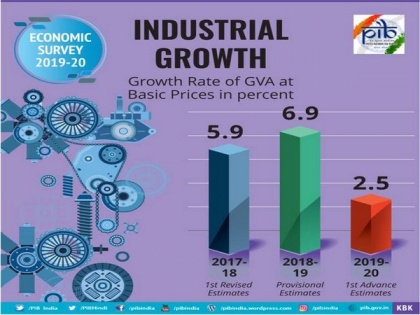Pro-business policies critical for India to become a $5 trillion economy: Economic Survey
By ANI | Published: January 31, 2020 09:08 PM2020-01-31T21:08:24+5:302020-01-31T23:00:23+5:30
The Economic Survey presented by Finance Minister Nirmala Sitharaman on Friday says India's aspiration to become a USD $5 trillion economy depends critically on promoting "pro-business" policy that unleashes the power of competitive markets to generate wealth and weng away from "pro-crony" policy that may favour specific private interests, especially powerful incumbents.

Pro-business policies critical for India to become a $5 trillion economy: Economic Survey
The Economic Survey presented by Finance Minister Nirmala Sitharaman on Friday says India's aspiration to become a USD $5 trillion economy depends critically on promoting "pro-business" policy that unleashes the power of competitive markets to generate wealth and weng away from "pro-crony" policy that may favour specific private interests, especially powerful incumbents.
The survey says that economic events since 1991 provide powerful evidence supporting this crucial distinction.
It says that creative destruction has increased significantly after the reform.
"The liberalization of the Indian economy in 1991 unleashed competitive markets and enabled the forces of creative destruction, generating benefits that we still witness today. Creative destruction brings new innovations in the market that serve people better than the old technologies they displace. It brings new firms into the markets, which compete with existing firms and lower prices for consumers," said a Finance Ministry release on the survey.
It says using the lens of Indian equity markets as captured in the S&P(Standard & Poor's) BSE Sensex, "we can clearly see an increase in market dynamism in the pro-business India of the post-liberalization period".
"After the market reforms of 1991, Sensex has grown at an accelerating pace. Whereas crossing the first incremental 5000 points took over 13 years and was achieved in 1999, the time taken to achieve each incremental milestone has substantially reduced over the years," it says.
The survey also gives a detailed analysis of the ways in which India will achieve the goal of becoming a USD 5 trillion economy.
It says industrial sector performance in terms of its contribution in Gross Value Added (GVA) improved in 2018-19 over 2017-18.
As per the estimates of Gross Domestic Product by National Statistical Office (NSO), the real GVA of the industrial sector grew by 1.6 per cent in first half (H1) (April-September) of 2019-20, as compared to 8.2 per cent in H1 of 2018-19. The low growth in the industrial sector is primarily due to the manufacturing sector which registered a negative growth of 0.2 per cent in 2019-20 H1.
Referring to Index of Industrial Production (IIP), the survey says its growth has moderated to 3.8 per cent in 2018-19 compared to 4.4 per cent in 2017-18.
During the current year 2019-20 (April-November), it grew at 0.6 per cent as compared to 5 percent in the corresponding period of previous year.
The moderation in growth is mainly arising from subdued manufacturing activities due to slower credit flow to Medium and Small industries, reduced lending by NBFCs owing to liquidity crunch and tapering of domestic demand for key sectors.
The survey says that Gross Capital Formation (GCF) in the industry has registered a rise from (-) 0.7 per cent in 2016-17 to 7.6 per cent in 2017-18 showing upward momentum of investment in the industry. Mining and quarrying, manufacturing, electricity, gas, water supply and other utility services and construction had registered a growth rate of 7.1 per cent, 8.0 per cent, 6.1 per cent and 8.4 per cent respectively in 2017-18.
Referring to the credit flow to the industrial sector, the survey says that growth in gross bank credit flow to the industrial sector, on a year-on-year basis, rose to 2.7 per cent in September 2019 as compared to 2.3 per cent in September 2018.
On corporate sector performance, the survey says that the manufacturing sector contracted in Q1 of 2019-20 mainly due to a production slowdown.
Petroleum products, iron and steel, motor vehicles and other transport equipment compes were the major contributors to the slowdown.
Referring to the performance of CPSEs, it says that of 348 Central Public Sector Enterprises (CPSEs) 249 are in operation, 86 CPSEs are yet to start commercial operations and 13 CPSEs are under closure/liquidation.
Out of 249 operating CPSEs, 178 CPSE showed profit during 2018-19, 70 CPSEs incurred losses during the year and one CPSE has shown neither profit nor loss.
The survey says that the growth of eight core industries (Coal, Crude Oil, Natural Gas, Refinery Products, Fertilizers, Steel, Cement and Electricity) stood flat during the current financial year (April-November, 2019).
During the corresponding period of the previous year, these industries grew at 5.1 per cent.
While fertilizers, steel and electricity have seen an expansion in their production, production of coal, crude oil, natural gas and refinery products have contracted during the current financial year, it says.
( With inputs from ANI )
Open in app